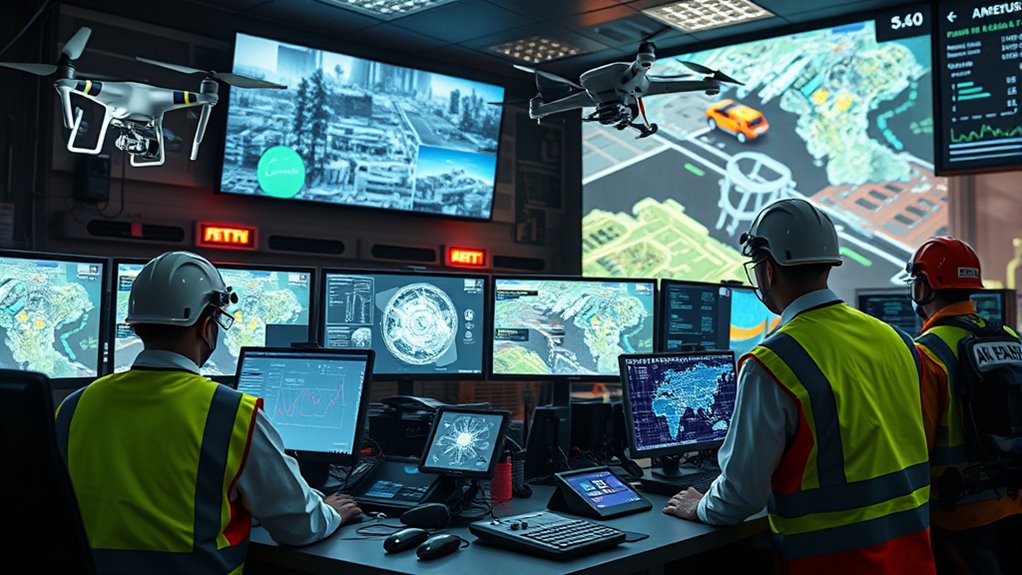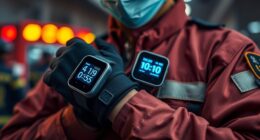AI plays a crucial role in disaster response by improving prediction, real-time data analysis, and deploying drones or robots for search and rescue. It helps optimize resources, streamline logistics, and provide early warnings to save lives. However, challenges like data privacy, ethical concerns, outdated infrastructure, and the need for human-AI collaboration remain. To discover how these opportunities and obstacles shape disaster management, keep exploring further.
Key Takeaways
- AI enhances disaster response through real-time data analysis, hazard detection, and rapid decision support.
- Opportunities include predictive modeling, resource prioritization, and improved situational awareness.
- Challenges involve data privacy concerns, infrastructure limitations, and ethical dilemmas.
- Sensor calibration and data validation are critical for reliable AI-driven hazard and vulnerability assessments.
- Effective AI deployment requires transparent algorithms, stakeholder collaboration, and infrastructure upgrades.
Predictive Modeling and Risk Assessment
Predictive modeling and risk assessment are at the forefront of leveraging AI to improve disaster response. By analyzing historical data, AI can forecast potential disaster hotspots and help prioritize resources. However, algorithm bias remains a concern, as biased data can lead to inaccurate predictions, disproportionately affecting vulnerable populations. You must guarantee your models are fair and representative to avoid these issues. Additionally, ensuring AI fairness involves continuous evaluation and adjustment of models to prevent unintended discrimination. Data privacy is equally critical; safeguarding sensitive information is essential to maintain public trust and comply with regulations. When collecting and using data for risk assessment, you should implement strict privacy measures and transparency protocols. Balancing accurate predictions with ethical considerations enhances AI’s effectiveness, ensuring disaster response efforts are both efficient and equitable. Moreover, ongoing AI Security monitoring is vital to detect and mitigate potential vulnerabilities that could undermine the reliability of predictive systems.
Real-Time Data Collection and Analysis

Real-time data collection enables you to quickly gather critical information from various sources during a disaster. This rapid data gathering helps you assess the situation accurately and make informed decisions on the spot. With AI-driven analysis, you get real-time decision support to respond more effectively and save lives. Moreover, the integration of advanced automation technologies can further enhance the speed and accuracy of data processing in emergency scenarios. Regular assessment and organization of collected data can optimize response strategies and ensure that vital information is readily available when needed. Additionally, employing vetted tools ensures the reliability and security of the data collected during critical moments. Incorporating specialized naming conventions can also improve data clarity and facilitate faster decision-making during crises. Recognizing the importance of emotional support for responders and affected populations can also improve overall resilience during disaster response efforts.
Rapid Data Gathering
How can responders quickly gather and analyze data during a disaster? AI enables rapid data collection through diverse sources like social media, sensors, and drones. This real-time influx helps responders assess situations swiftly while balancing data privacy concerns. Additionally, leveraging antioxidant properties can aid in identifying health risks from contaminated environments. Incorporating data privacy protocols is essential to protect individuals’ personal information during these processes. However, ethical dilemmas arise around collecting personal information without consent. To enhance effectiveness, consider:
- Implementing secure, privacy-preserving data protocols
- Using AI to filter relevant, credible information rapidly
- Ensuring transparency about data sources and usage
- Incorporating mindfulness practices to remain focused and ethical during data analysis
- Promoting public trust by clearly communicating data collection methods and purposes
- Utilizing AI analytics tools to help interpret complex data streams and identify critical insights quickly
These strategies allow for quick, informed decisions while respecting ethical boundaries. The challenge lies in managing vast data streams without compromising privacy or facing ethical pitfalls. By leveraging AI thoughtfully, responders can optimize rapid data gathering, improve response times, and maintain public trust during crises.
Accurate Situation Assessment
Building on rapid data collection, accurate situation assessment depends on how effectively you analyze the incoming information. Proper sensor calibration guarantees data accuracy, reducing errors caused by faulty readings. When sensors are correctly calibrated, AI algorithms can interpret data more reliably, providing a clearer picture of the disaster’s scope. Data redundancy plays an essential role here; by collecting overlapping information from multiple sources, you minimize gaps and verify critical details. This redundancy helps identify inconsistencies, allowing you to filter out noise and focus on trustworthy data. Combining precise sensor calibration with strategic data redundancy ensures your analysis is both accurate and exhaustive. Implementing color accuracy and calibration techniques can significantly enhance the reliability of collected data. Additionally, consistent monitoring of eye patch benefits can serve as an analogy, illustrating how multiple layers of data and monitoring lead to more reliable assessments. Incorporating data validation methods can help further improve the trustworthiness of the information collected, ensuring more effective decision-making. Moreover, leveraging noise reduction technology can further improve data quality by minimizing interference and false signals. This foundation enables responders to form a detailed understanding of the situation quickly, supporting effective response strategies.
Real-Time Decision Support
As disaster situations unfold rapidly, timely data collection and analysis become essential for effective response. AI-powered real-time decision support systems help you swiftly interpret incoming data, enabling informed actions. However, challenges like AI bias can skew insights, risking misallocation of resources. Ensuring data privacy is equally crucial; sensitive information must be protected to maintain trust and compliance. To optimize this process, consider:
- Implementing unbiased algorithms to reduce AI bias
- Establishing strict data privacy protocols
- Continuously validating data accuracy for reliable analysis
- Utilizing diverse and reliable data sources to improve the robustness of AI insights, including verified data from authorized agencies and community reports. Incorporating accurate and timely data is vital to enhance overall response effectiveness and minimize errors. Additionally, fostering collaborative data sharing among agencies can further strengthen the quality and comprehensiveness of the information used. Leveraging data integration techniques can also help synthesize data from multiple sources for more comprehensive situational awareness.
Drone and Robot Deployment in Search and Rescue

Drones and robots can quickly explore large or dangerous areas, giving rescue teams a clearer picture of the situation. They detect hazards in real time, helping responders avoid risks and plan effective strategies. This technology substantially improves search and rescue efforts in disaster zones.
Enhanced Area Exploration
How can we effectively explore disaster zones to locate survivors quickly? AI-powered drones and robots enhance area exploration by combining satellite imaging and terrain mapping. These tools provide detailed aerial views, allowing you to identify hazardous areas and search routes efficiently. They can navigate collapsed structures or flooded zones, reaching places humans can’t access safely. By integrating satellite data, you get real-time updates on terrain changes and survivor locations, speeding up rescue efforts. This approach minimizes risks and maximizes coverage, ensuring no area is overlooked. Emerging technologies continue to improve the speed and safety of search and rescue missions, making operations more effective. Additionally, leveraging real-time data from various sources allows rescue teams to adapt their strategies dynamically, further enhancing the effectiveness of disaster response efforts. Furthermore, incorporating vibrational cues can aid in detecting signs of life in inaccessible areas, boosting rescue success rates.
Real-Time Hazard Detection
Have you ever wondered how rescue teams detect hidden hazards in real time during a disaster? AI-powered drones and robots play an essential role by providing immediate hazard detection, but they require precise sensor calibration to guarantee accurate data. These devices scan the environment for signs of danger—such as gas leaks or unstable structures—allowing responders to act swiftly. However, managing data privacy remains a challenge; sensitive information collected by drones must be protected to prevent misuse. By continuously calibrating sensors and safeguarding data, you can improve the reliability of hazard detection and maintain trust with affected communities. This real-time insight helps save lives and reduces risks for rescue personnel, making AI-driven deployment an invaluable tool in disaster response.
Resource Allocation and Logistics Optimization
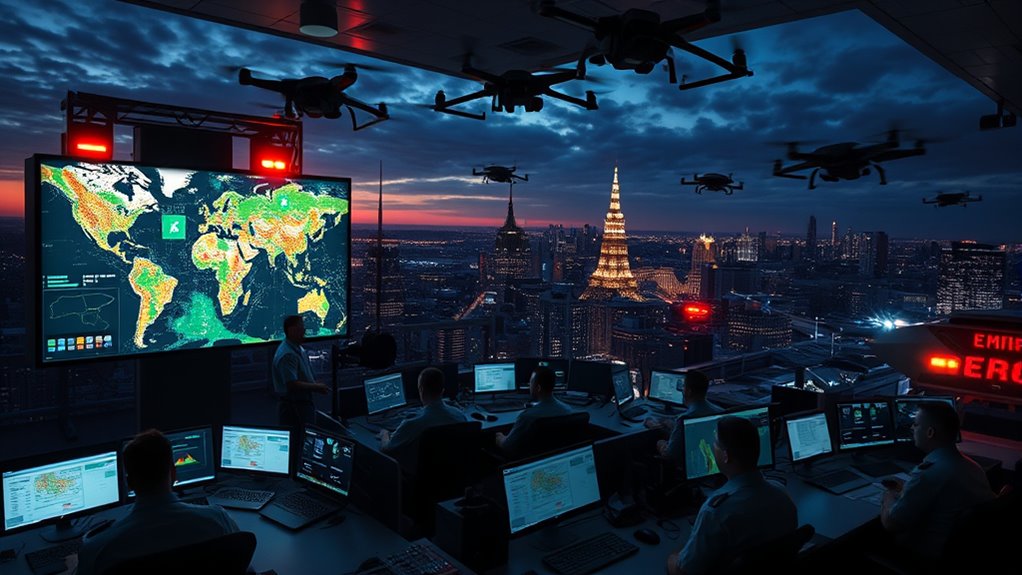
Ever wondered how AI can streamline resource allocation and logistics during disasters? AI enhances resource prioritization by identifying areas with the greatest need, ensuring supplies reach those who need them most. It also bolsters supply chain resilience, allowing real-time adjustments to disruptions and delays. With AI, you can optimize logistics routes, reducing delivery times and fuel consumption. This technology predicts demand surges, enabling preemptive stockpiling and distribution.
- Dynamic inventory management for rapid response
- Real-time analytics to adapt to evolving conditions
- Automated dispatch systems for efficient resource deployment
Early Warning Systems and Evacuation Planning
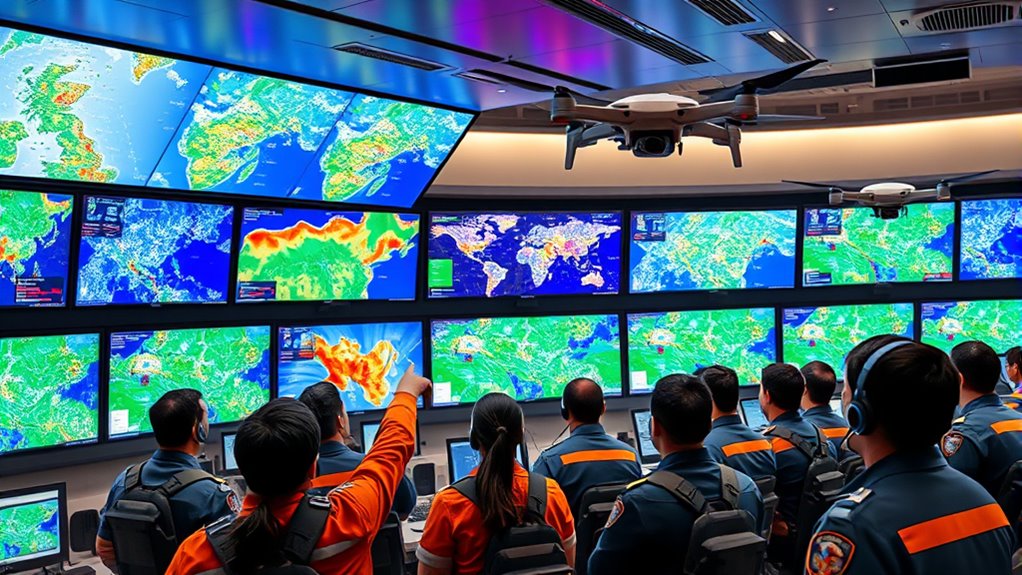
AI-driven early warning systems detect signs of impending disasters with remarkable speed and accuracy, giving communities crucial time to prepare. Your active engagement with these alerts can save lives and reduce damage. By integrating AI into policy development, authorities can create effective evacuation plans tailored to specific risks. Community involvement ensures plans address real needs, fostering trust and cooperation. These systems also facilitate real-time updates, helping you respond swiftly. Consider this:
| Impact of AI in Disaster Response | Human Element |
|---|---|
| Faster alerts save lives | Community trust builds resilience |
| Better evacuation routes | Increased community engagement |
| Precise risk assessment | Empowered citizens |
| Enhanced preparedness | Stronger policies |
With AI, your community becomes more resilient, turning technology into a tool for hope and safety.
Ethical Considerations and Privacy Concerns

As AI becomes more integrated into disaster response, ethical considerations and privacy concerns take center stage. You must address data bias, which can lead to unfair or inaccurate decisions, and accountability issues if AI systems malfunction or cause harm. Protecting individuals’ privacy is essential, especially when sensitive data like health or location information is involved. Failure to do so risks eroding public trust and violating rights. Consider these key points:
- Ensuring transparency in AI decision-making processes
- Implementing robust data privacy measures
- Clarifying responsibility when errors occur
Infrastructure and Technological Challenges
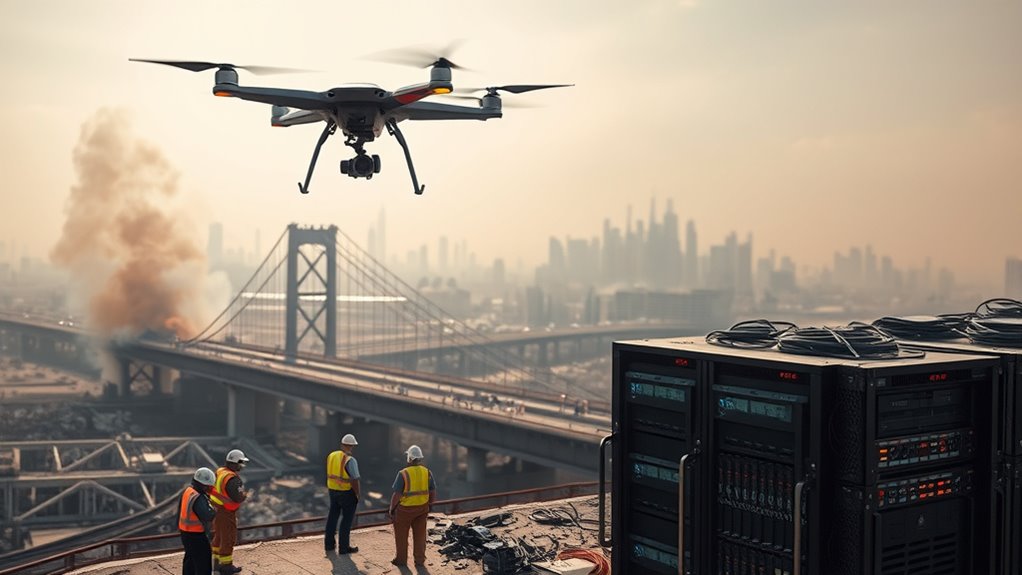
Implementing AI in disaster response faces significant infrastructure and technological challenges that can hinder effectiveness. Many urban areas lack the resilience needed to support advanced AI systems, especially during crises. Outdated infrastructure often cannot handle the data processing demands or the real-time communication required for efficient responses. Upgrading infrastructure is essential but costly and time-consuming, delaying deployment. Additionally, integrating new AI technologies into existing systems can be complex, requiring specialized expertise. Without reliable connectivity and robust hardware, AI tools may fail when they’re needed most. Overcoming these hurdles requires strategic investments in infrastructure upgrades to ensure urban resilience. Only then can AI truly enhance disaster response capabilities, providing faster, more accurate decision-making during emergencies.
Collaboration Between Human Responders and AI Systems
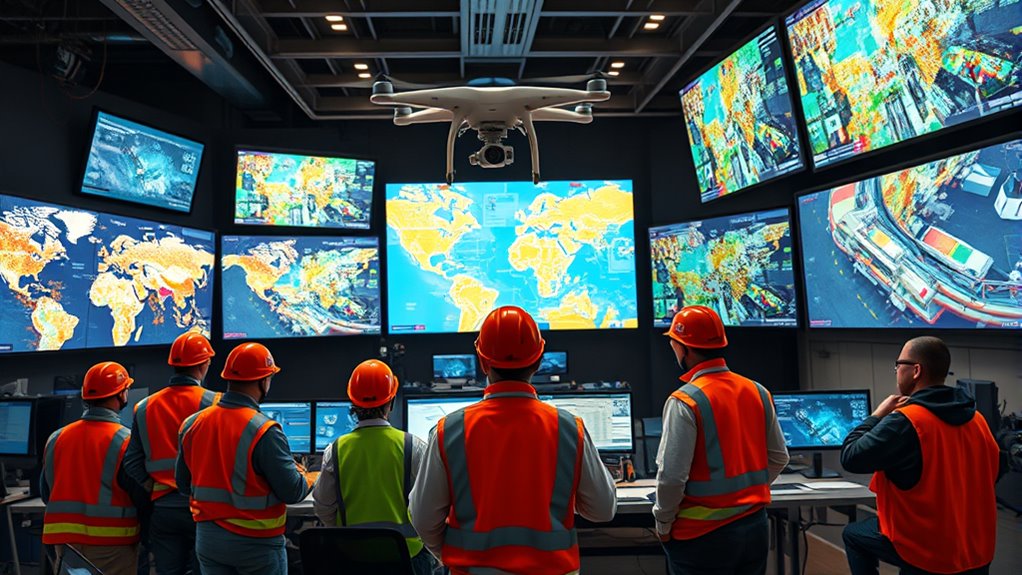
While AI systems can process vast amounts of data quickly, their effectiveness depends on seamless collaboration with human responders. Building human trust is essential for effective integration, as responders need confidence in AI outputs. Ensuring smooth collaboration involves addressing training requirements, so responders understand AI capabilities and limitations. To foster this partnership, consider:
Successful AI-human collaboration hinges on trust, training, and clear communication.
- Providing targeted training programs to improve responder understanding of AI tools
- Establishing clear communication protocols for decision-making and data sharing
- Developing user-friendly interfaces that enhance responsiveness and trust
Future Directions and Innovations in AI-Driven Disaster Management

Advancements in AI technology are shaping the future of disaster management, opening new possibilities for faster and more accurate responses. One promising direction is AI-enabled community engagement, allowing residents to provide real-time updates and feedback during crises, which improves situational awareness. Additionally, AI-driven insights can inform policy development, ensuring responses are data-informed and adaptable to evolving threats. Future innovations may include predictive analytics that identify vulnerabilities before disasters strike, or autonomous systems that assist in rescue operations. These developments will foster more resilient communities and streamlined coordination among responders. To maximize these benefits, you’ll need to focus on integrating AI solutions with existing policies, promoting transparency, and ensuring community participation in the decision-making process.
Frequently Asked Questions
How Does AI Handle Data Inaccuracies During Disasters?
When facing data inaccuracies during disasters, AI relies on sensor reliability and data validation to guarantee accuracy. You can trust that AI systems cross-check incoming data from multiple sensors and apply validation algorithms to identify inconsistencies. This process helps filter out errors, allowing you to make informed decisions quickly. By continuously updating and validating data, AI adapts to changing conditions, improving response effectiveness despite potential inaccuracies.
What Training Do Responders Need to Work With AI Systems?
You need responder training that covers AI ethics, technical skills, and decision-making. This training guarantees you understand AI systems, recognize ethical considerations, and make informed choices. It’s about learning to interpret AI outputs, handle data responsibly, and adapt to evolving technology. With proper responder training, you build confidence, enhance collaboration, and improve disaster response effectiveness, all while respecting ethical standards and harnessing AI’s full potential in crisis situations.
Can AI Predict Long-Term Disaster Recovery Outcomes?
You might wonder if AI can predict long-term disaster recovery outcomes. While AI excels at short-term forecasting, its capabilities in long-term recovery modeling are evolving. Advanced algorithms analyze data patterns to forecast recovery timelines and challenges, but uncertainties remain. You should stay updated on AI developments, as improving long-term forecasting can help plan better strategies, ensuring resources are allocated effectively for sustained recovery efforts.
How Is AI Integrated With Existing Disaster Response Protocols?
Imagine a world where your disaster response protocols smoothly embrace AI integration. You adapt existing protocols by incorporating AI tools that enhance decision-making and resource allocation. This process involves protocol adaptation, ensuring AI complements traditional methods without disruption. As you integrate AI, you streamline operations, improve response times, and better coordinate efforts, making your disaster management more efficient and resilient. Embracing AI helps you create a proactive, responsive approach for future emergencies.
What Are the Costs Associated With Implementing AI in Disaster Response?
When you consider implementing AI in disaster response, you need to conduct a thorough cost analysis to understand the expenses involved. Budget considerations include not only the initial investment in technology and infrastructure but also ongoing costs like maintenance, updates, and training. These costs can be significant, so balancing the potential benefits against the financial investment is vital to guarantee effective and sustainable AI integration in emergency efforts.
Conclusion
As you explore AI’s role in disaster response, remember that AI can improve response times by up to 30%, saving lives and reducing damage. While challenges like ethical concerns and infrastructure hurdles exist, embracing technological innovations can make your disaster management efforts more effective. By collaborating with AI systems, you become part of a future where rapid, data-driven decisions can better protect communities during crises. The potential is enormous—are you ready to harness it?

